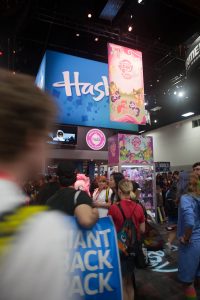The My Little Pony franchise is one of Hasbro’s biggest moneymakers next to Transformers. Primarily a toy company, Hasbro started using TV shows to market its toys in the 80’s, with great results. The shows brought the toys to the attention of the children, who wanted to continue the adventures after the show ended. The 2011 reboot brought with it an unexpected adult fanbase, so Hasbro turned to transmedia storytelling to attempt to appease both demographics.
The new franchise Equestria Girls, four theatrical films starring human doppelgangers of the pony characters, makes good use of the format of YouTube videos. They have several choose your own adventure shorts using YouTube’s annotations and endcards to direct users to alternate endings to a storyline. They also upload more standard shorts directly to YouTube, since they know that not many kids are going to buy a DVD and they aren’t forced to follow a strict time limit like on TV. They are definitely adhering to Jenkin’s statement that “In the ideal form of transmedia storytelling, each media does what it does best.” In this way, they are similar to Peg + Cat, which Vicky talks about in her blog post.
The movie, on the other hand, relies too much on its comics for the full story to be told. With six main characters to focus on and twice as many new characters introduced, this was a tall order for Hasbro. In an attempt to make the movie easier to follow, they cut out large parts of the story relating to the new characters and published them as comics instead. This was fine for hardcore bronies and children who had money and access to comics, but not for most of the target demographic. In a sense, the comics were required reading in order to fully understand the movie, which hurt both the comics and the movie because both ended up being confusing on their own. They did not tell a complete, self-contained story that was accessible to everyone.
The attempt at transmedia in this case went wrong because of accessibility. When a TV show has a website, it’s a fair bet that someone who has access to television also has a computer or vice versa. Also, computers can play video so TV episodes can be viewed online. While reading supplemental material can enhance the experience of watching a movie or TV show and vice versa, one should never be required to enjoy the other because there’s no guarantee that the viewer will have access to both. This is where Hasbro fails and Marvel excels (Kes talks about this in depth). As someone who has only recently gotten into comics, I do not feel alienated by the Marvel movies. There are small references to events in the comics but they are either universal enough that non-comics fans enjoy them too or small enough to not affect the viewing experience. Without the comics, the characters in the Marvel movies are still complete, well-rounded characters and the viewer knows enough about them and their world to be invested in their adventures.
Knowing that there are little details that are from the comics makes me want to read them, but I don’t feel like I have to in order to fully understand the movie. Hasbro fails at this in the 2017 My Little Pony Movie because they did not expand the universe, they divided it.
Jenkins thinks that this kind of division is a good thing because it makes a story more complex and utilizes the strengths of various media to minimize the weaknesses. I think he makes some good points but I disagree that it is always a good thing. I think having easter eggs that tie various parts of a story together is a great way to encourage the audience to seek out the other forms of media. However, having important plot details scattered throughout various forms of media that people might not have knowledge about or access to limits the experience to only hardcore fans with big wallets and lots of free time. Hardcore fans are a very small group, so this is not good business and will make the company look bad in the long run.
Word Count: 699
